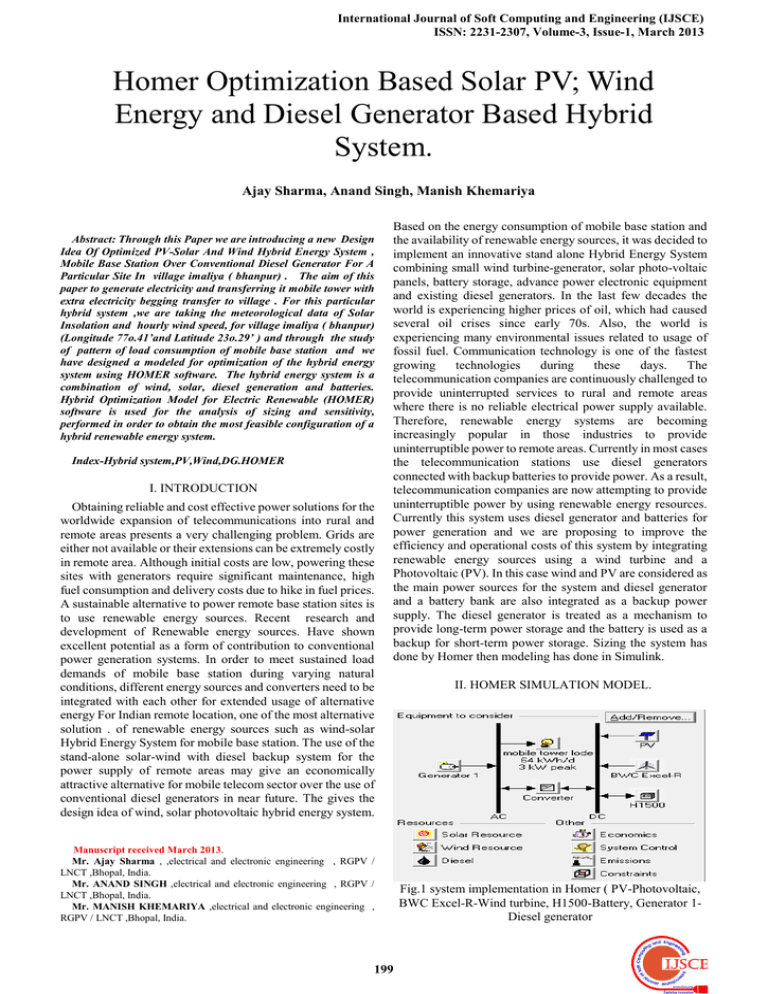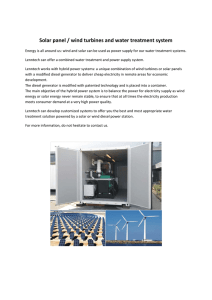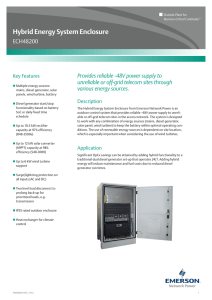
International Journal of Soft Computing and Engineering (IJSCE)
ISSN: 2231-2307, Volume-3, Issue-1, March 2013
Homer Optimization Based Solar PV; Wind
Energy and Diesel Generator Based Hybrid
System.
Ajay Sharma, Anand Singh, Manish Khemariya
Abstract: Through this Paper we are introducing a new Design
Idea Of Optimized PV-Solar And Wind Hybrid Energy System ,
Mobile Base Station Over Conventional Diesel Generator For A
Particular Site In village imaliya ( bhanpur) . The aim of this
paper to generate electricity and transferring it mobile tower with
extra electricity begging transfer to village . For this particular
hybrid system ,we are taking the meteorological data of Solar
Insolation and hourly wind speed, for village imaliya ( bhanpur)
(Longitude 77ο.41’and Latitude 23ο.29’ ) and through the study
of pattern of load consumption of mobile base station and we
have designed a modeled for optimization of the hybrid energy
system using HOMER software. The hybrid energy system is a
combination of wind, solar, diesel generation and batteries.
Hybrid Optimization Model for Electric Renewable (HOMER)
software is used for the analysis of sizing and sensitivity,
performed in order to obtain the most feasible configuration of a
hybrid renewable energy system.
Index-Hybrid system,PV,Wind,DG.HOMER
I. INTRODUCTION
Obtaining reliable and cost effective power solutions for the
worldwide expansion of telecommunications into rural and
remote areas presents a very challenging problem. Grids are
either not available or their extensions can be extremely costly
in remote area. Although initial costs are low, powering these
sites with generators require significant maintenance, high
fuel consumption and delivery costs due to hike in fuel prices.
A sustainable alternative to power remote base station sites is
to use renewable energy sources. Recent research and
development of Renewable energy sources. Have shown
excellent potential as a form of contribution to conventional
power generation systems. In order to meet sustained load
demands of mobile base station during varying natural
conditions, different energy sources and converters need to be
integrated with each other for extended usage of alternative
energy For Indian remote location, one of the most alternative
solution . of renewable energy sources such as wind-solar
Hybrid Energy System for mobile base station. The use of the
stand-alone solar-wind with diesel backup system for the
power supply of remote areas may give an economically
attractive alternative for mobile telecom sector over the use of
conventional diesel generators in near future. The gives the
design idea of wind, solar photovoltaic hybrid energy system.
Based on the energy consumption of mobile base station and
the availability of renewable energy sources, it was decided to
implement an innovative stand alone Hybrid Energy System
combining small wind turbine-generator, solar photo-voltaic
panels, battery storage, advance power electronic equipment
and existing diesel generators. In the last few decades the
world is experiencing higher prices of oil, which had caused
several oil crises since early 70s. Also, the world is
experiencing many environmental issues related to usage of
fossil fuel. Communication technology is one of the fastest
growing
technologies
during
these
days.
The
telecommunication companies are continuously challenged to
provide uninterrupted services to rural and remote areas
where there is no reliable electrical power supply available.
Therefore, renewable energy systems are becoming
increasingly popular in those industries to provide
uninterruptible power to remote areas. Currently in most cases
the telecommunication stations use diesel generators
connected with backup batteries to provide power. As a result,
telecommunication companies are now attempting to provide
uninterruptible power by using renewable energy resources.
Currently this system uses diesel generator and batteries for
power generation and we are proposing to improve the
efficiency and operational costs of this system by integrating
renewable energy sources using a wind turbine and a
Photovoltaic (PV). In this case wind and PV are considered as
the main power sources for the system and diesel generator
and a battery bank are also integrated as a backup power
supply. The diesel generator is treated as a mechanism to
provide long-term power storage and the battery is used as a
backup for short-term power storage. Sizing the system has
done by Homer then modeling has done in Simulink.
Manuscript received March 2013.
Mr. Ajay Sharma , ,electrical and electronic engineering , RGPV /
LNCT ,Bhopal, India.
Mr. ANAND SINGH ,electrical and electronic engineering , RGPV /
LNCT ,Bhopal, India.
Mr. MANISH KHEMARIYA ,electrical and electronic engineering ,
RGPV / LNCT ,Bhopal, India.
199
II. HOMER SIMULATION MODEL.
Fig.1 system implementation in Homer ( PV-Photovoltaic,
BWC Excel-R-Wind turbine, H1500-Battery, Generator 1Diesel generator
Homer Optimization Based Solar PV; Wind Energy and Diesel Generator Based Hybrid System.
III. SYSTEM SIZING
B .Photovoltaic Array
The Hybrid Energy System Sizing Is Done In Hybrid
Optimization Model For Electrical Renewable (HOMER)
Software And A System Implementation. The Proposed
System Comprises Primary Renewable Sources (Wind/PV)
Which Are Placed With A Standby Secondary
Non-Renewable Sources (Diesel Generator/Batteries), And
Converter Is Included In The System To Connect Between
AC And DC Links. The HOMER software is used to
determine the best optimal sizing and pre-feasibility study of
the system. Sensitivity analysis is considered when designing
the system.
Solar PV modules are connected in series parallel. When the
sunrays strike the Solar PV panels, it produces electricity. A 1
kW solar energy system’s installation, and replacement costs
are taken approximate as $5000 and $3000, respectively. The
lifetime of a PV is taken to be 20 years.
A. Wind Turbine
Two wind turbines from Bergey Wind Power having the
model BWC-Excel-R are used in this system. Each turbine
has rated capacity of 7.5kW and provides DC. The Cost of
one unit is considered to be, capital cost is estimated as
$15000, replacement cost is estimated as $13000, and annual
operation and maintenance cost is estimated as $15. the
simulation program find an optimum solution, lifetime of a
turbine is taken to be 15 years.the power curve in show in fig
.2 and the wind resource show in fig.3.
Fig. 4 Monthly solar radiation
C. Diesel Generator
The fuel consumption per year is approximate 1400 Litter for
1kW Diesel Generator. The 0.500 kW diesel generator capital
cost, replacement cost, operation-maintenance cost are 200$,
150 $, 0.010$. The lifetime of a diesel generator operating
hour 15000.
Fig . 2 Power curve
D. Battery
The battery type Hop-picker 12 Opzs 1500. Nominal space
2V ,1500 AH , 3KWH . These batteries are replaced every 10
years. The one battery initial capital cost, replacement coast,
and maintenance and operation coast of $700, $500, and $5
respectively.
E. Power Converter
A converter is included in order to maintain the flow of energy
between the AC and the DC bus.
The conventional load is DC type, but generated power from
diesel generator is AC type. The size of the convertor that is
used in this system is 3kW. The initial capital cost and
replacement cost and operation-maintenance cost are $2000,
$1500 and 20 respectively.
IV. SIMULATION RESULT
The Monthly Average Electric Production Of The System.
Photovoltaic Production Is 37%, Diesel Generator Production
Is 34%, And Wind Turbine Is 28%.The Monthly Average
Electricity Production of Hybrid Energy System for mobile
telephony base station.
Fig. 3 Wind resource
200
International Journal of Soft Computing and Engineering (IJSCE)
ISSN: 2231-2307, Volume-3, Issue-1, March 2013
Fig. 5 Case flow summaries
Fig .8 PV array power output daily profile
Fig. 6 Annual electricity productions by different hybrid
system
Fig.9Wind speed at anemometer height daily profile
Fig.7 BWC Excel –R-output
A. SIMULATION TIME SERIES
Fig.10 BWC Excel –R- power output daily profile
201
Homer Optimization Based Solar PV; Wind Energy and Diesel Generator Based Hybrid System.
Fig.14 Battery discharge power daily profile
Fig .11Total renewable power output daily profile
Fig 15 Global horizontal solar radiation monthly averages
Fig.12 Generator 1 electrical output daily profile
Fig.13Battery charge power daily profile
Fig 16 Total renewable power output daily profile
202
International Journal of Soft Computing and Engineering (IJSCE)
ISSN: 2231-2307, Volume-3, Issue-1, March 2013
Fig 18 Optimization Results Of Hybrid Energy System For
Mobile Telephony Base Station
Fig 17 Total electrical lode served daily profile
V. OPTIMIZATION RESULT
VI. CONCLUSION
HOMER Software Performs Several Simulations In Order
To Obtain The Optimal Hybrid System. Four Sensitivity
Variables Are Considered In This System And They Are
Wind Speed, Solar Irradiation, Load, And Diesel Price And
Each Of These Variables Has Three Different Values. The
Optimization Results The Best Optimal Combination Of
Energy System Components Are Two 7.5kw BWC-Excel-R ,
1 KW PV-Array And 2 00.500 KW Diesel Generator. Total
Net Present Cost (NPC), Capital Cost And Cost Of Energy
(COE) For Such A System Is $112174,$ 59400 And
0.692$/Kwh, Respectively For One Year. The optimization
result in show in fig 18.
This paper presented a proposed hybrid power system for a
remote telecommunication site in imaliya (bhanpur). System
sizing and designed system configuration is presented. In
India more than 2 billion peoples are sell phone. To provide
better network services sell phone operator installed new sell
phone base stations. Power is main issue for remote or
isolated areas base station, because grid extension is not
feasible. This sites proposed renewable base hybrid system is
most viable solution. These solutions of power supply to the
telecom base station are cost effective and available
throughout the year. The circumstance of each sites are
studied in order to decide the feasible combination of
alternative energy resources. Alternate power solutions are
not commonly used in tower telecommunication system today
but are actively evaluated for remote and isolated areas over
worldwide. With the help of above pre-feasibility study the
solar and wind hybrid energy system are most viable power
solution for sell phone base station in Indian sites over
conventional diesel generator. Although the net present cost is
high but the running and maintenance cost are low as
compared to the diesel generator power solution. The
Monthly Average Electric Production of The System.
Photovoltaic Production Is 37%, Diesel Generator roduction
Is 34%, And Wind Turbine Is 28%.Total Net Present Cost
(NPC), Capital Cost And Cost Of Energy (COE) For Such A
System Is $112174,$ 59400 And 0.692$/Kwh, Respectively
For One Year Its payback time is around 20 years.
REFERENCES
1.
2.
3.
4.
203
Mohamed El Badawe¹, Tariq Iqbal and George K. I. Mann”
Optimization And Modeling Of A Stand-Alone Wind/Pv Hybrd Energy
System” 2012 25th IEEE Canadian Conference on Electrical and
Computer Engineering (CCECE) 2012 IEEE
Shahriar Ahmed Chowdhury1, Shakila Aziz2 “Solar-Diesel Hybrid
Energy Model for Base Transceiver Station (BTS) of Mobile Phone
Operators” Centre for Energy Research, United International
University, Dhaka, Bangladesh.
Pragya Nema1, R.K. Nema2, Saroj Rangnekar1” PV-Solar / Wind
Hybrid Energy System For GSM/CDMA Type Mobile Telephony Base
Station” ISSN 2076-2895 (Print), ISSN 2076-2909 (Online) ©2010
International Energy & Environment Foundation. All rights reserved.
Sthitaprajna Rath, S.M Ali, Md. Nadeem Iqbal “ Strategic Approach
Of Hybrid Solar-Wind Power For Remote Telecommunication Sites In
Homer Optimization Based Solar PV; Wind Energy and Diesel Generator Based Hybrid System.
5.
6.
7.
8.
9.
10.
11.
12 .
13.
14.
15.
16.
17.
18.
19.
20.
INDIA” International Journal of Scientific & Engineering Research,
Volume 3, Issue 6, June-2012 1 ISSN 2229-5518.
Dulal Ch Das, A K Roy, N Sinha, “PSO Based Frequency Controller
For Wind- Solar- Diesel Hybrid Energy Generation/Energy Storage
System” 978-1-4673-0136-7/11 ©2011 IEEE
Agus
Yogianto(1),
Hendra
Budiono(2),
Indra
A.
Aditya(3)”Configuration Hybrid Solar System(Pv), Wind Turbine,
And Diesel” @2012 Ieee
E. C. Dos Santos Jr.2, C. B. Jacobina1, M. B. R. Correa1, N. Rocha1”
Distributed Generation System Based On Single-Phase Grid, Induction
Generator And Solar Photovoltaic Panel” ©2008 IEEE
Saeed lahdi Loi Lei Lai, Daniel Nankoo,” Grid Integration Of
Wind-Solar Hybrid Renewables Using AC/DC Converters As DG
Power Sources” ©2011 IEEE
B. Mangu, K. Kiran Kumar and B. G. Fernandes” A Novel Grid
Interactive Hybrid Power Supply System For Telecom Application”
Indian Institute of Technology Bombay, Powai, Mumbai-400076,
India.
Kumaravel S. Dr. Ashok S.” Adapted Multilayer Feedforward Ann
Based Power Management Control Of Solar Photovoltaic And Wind
Integrated Power System” ©2011 IEEE.
R.Goutham Govind Rajul M. Vinothkurnar3 N.Kamalakannan
.P.Subramaniam “A Hybrid Alternative Energy System with
Photovoltaic and Fuel Cell” ©2011 IEEE.
Razak, N.A.B.A.; Bin Othman, M.M.; Musirin, I, “Optimal Sizing
And Operational Strategy Of Hybrid Renewable Energy System Using
Homer”, 4th International Power Engineering And Optimization
Conference (PEOCO), 2010, Pp495-501, June 23-24, 2010.
Lagorse, J; Giurgea, S; Paire, D; Cirrincione, M; Simoes, M.G ;
Miraoui, A; , “Optimal Design Analysis Of A Stand-Alone
Photovoltaic Hybrid System”, IEEE Industry Applications Society
Annual Meeting, 2008. IAS '08, Pp1-7, Oct 5-9, 2008.
Reaz Ul Haque ; M. T. Iqbal ; John E. Quaicoe ; “Sizing, Dynamic
Modeling And Power Electronics Of A Hybrid Energy System”,
Canadian Conference On Electrical And Computer Engineering, 2006.
CCECE '06. , Pp1135-1138, May 2006.
Juhari Ab. Razak, Kamaruzzaman Sopian, Yusoff Ali, “Optimization
Of Renewable Energy Hybrid System By Minimizing Excess
Capacity”, International Journal Of Energy, Vol. 1, 2007.
Bajpai, P. ; Kumar, S. ; Kishore, N.K. ; “Sizing Optimization And
Analysis Of A Stand-Alone Wtg System Using Hybrid Energy Storage
Technologies”, International Conference On Energy And Sustainable
Development: Issues And Strategies (Esd 2010), Pp1-6, June 2-4,
2010.
Furat Abdal; Rassul Abbas; Mohammed Abdulla Abdulsada;
“Simulation Of Wind-Turbine Speed Control By MATLAB”,
International Journal Of Computer And Electrical Engineering, Vol. 2,
October, 2010
Yang HX, Lu L, Burnett J. Weather Data And Probability Analysis Of
Hybrid Photovoltaic–Wind Power Generation Systems In Hong Kong.
Renew Energy 2003, 28(11), 1813–24.
Celik A.N. The System Performance Of Autonomous
Photovoltaic–Wind Hybrid Energy Systems Using Synthetically
Generated Weather Data. Renewable Energy 2002, 27, 107–121.
Shaahid SM, Elhadidy MA. Opportunities For Utilization Of
Stand-Alone Hybrid (Photovoltaic+ Diesel+Battery) Power Systems In
Hot Climates. Renew Energy 2003, 28 (11), 1741–53.
204



